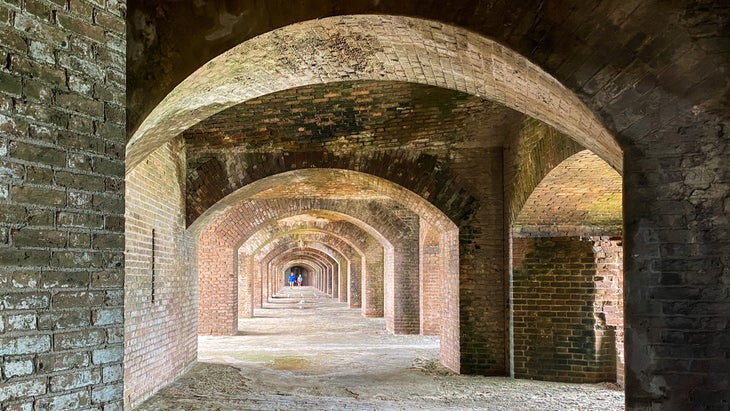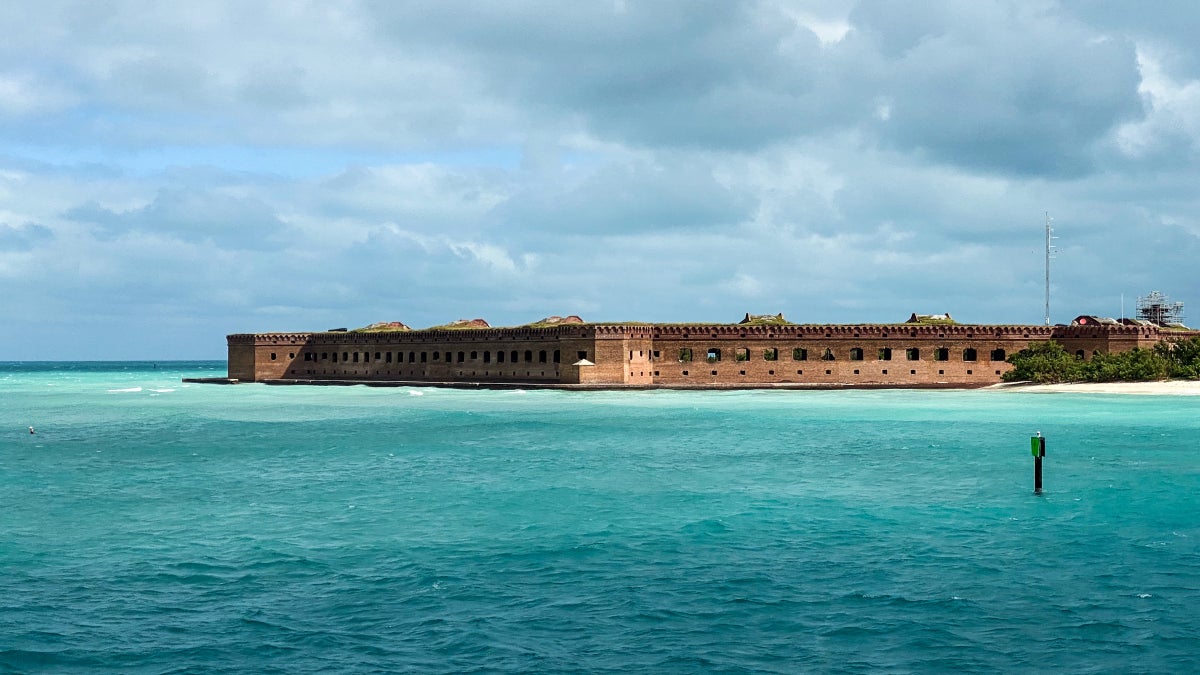No products in the cart.
Outdoor Adventure
Dry Tortugas National Park: Haunted by History, Heralded for Its Marine Life
63 Parks Traveler started with a simple goal: to visit every U.S. national park. Avid backpacker and public-lands nerd Emily Pennington saved up, built out a tiny van to travel and live in, and hit the road, practicing COVID-19 best safety protocols along the way. The parks as we know them are rapidly changing, and she wanted to see them before it’s too late. The Dry Tortugas is her 57th park visit.
A strong wind whipped the tops of the palms into a frenzy as I boarded the Yankee Freedom in Key West, Florida. Dry Tortugas is one of the country’s few island-centric national parks, and getting to its remote location, 70 miles due west, would be a challenge, even in good weather. I gritted my teeth and zipped up my wind shell as the boat rocked and rolled for nearly two and a half hours.
Like a mirage, the park appeared, a small series of islets surrounded by glittering, aquamarine seawater, with its main attraction—the Civil War–era Fort Jefferson—sitting squat in the middle of Garden Key, massive and rust red.
Given the gales, as soon as I disembarked, I sprinted to the shelter of the fort for a guided tour. The hexagonal structure was enormous—built on 47 acres, with over 16 million handmade bricks, the project took over 30 years to complete—and it inspired daydreams of pirates and frigate ships as I stood in its center. Our guide, a long-haired Floridian in cargo shorts and wraparound shades, led the group around the surprisingly green, overgrown fields within the citadel, past historic cannons and hallways that reminded me of an M.C. Escher drawing.

The Dry Tortugas were first discovered by Ponce de León on an expedition in 1513, named for their lack of fresh water and an abundance of delicious sea turtles, which sailors ate. Pirates frequented the area throughout the 1700s, often using the small islands as a base and attacking merchant ships en route to and from the Gulf of Mexico. But real development didn’t commence here until after the War of 1812; the U.S. government acquired the Dry Tortugas from Spain and decided to build a string of coastal forts from Maine to Texas, with Fort Jefferson to be the grandest of them all. The reasoning was that, as a budding superpower, it needed the Dry Tortugas to defend one of the most strategic deep-water anchorages in North America. Later, when the Civil War commenced, it was this fort that helped blockade southern shipping routes, strengthening the Union Army.
Wandering around with only a few dozen tourists behind me, it was hard to imagine that this bastion once housed nearly 2,000 men and women, many of whom were enslaved people tasked with the backbreaking labor of erecting the huge fortress.
When the tour concluded, I shuffled off with an armful of borrowed snorkeling gear, bobbing up and down in the choppy, azure waves as I tried to make out the odd bit of coral or sea sponge. The park was the first marine area ever designated as a national monument, and with its abundance of Technicolor tropical fish, nesting sea turtles, and vast colonies of seabirds, it was easy to see why. I was adrift in an oasis of life.
I boarded the return ship feeling spacey and blissed-out, as though I’d just been tumbled through an ocean of time itself. The return trip was arduous, freezing, and unsteady, with salt water spraying over the ferry’s hull for hours. But I didn’t care. Lost in daydream, the long ride made me realize just how remote the park was and how much more remarkable that made it.
63 Parks Traveler Dry Tortugas Info
Size: 47,125 acres
Location: Southwest Florida, 70 miles from Key West
Created In: 1935 (Fort Jefferson National Monument), 1992 (Dry Tortugas National Park)
Best For: Boating, history buffs, snorkeling, diving, birding, lounging on the beach
When to Go: June through November (70 to 92 degrees) is considered hurricane season in this region, and ferry service is regularly canceled when storms strike. December (67 to 76 degrees) to May (75 to 86 degrees) are the most temperate months to visit and less prone to foul weather.
Where to Stay: Before and after your trip, you’ll likely want to bask in the quirky beach town of Key West, home to breezy bungalows, developed campgrounds, and, of course, infinite slices of Key lime pie.
Mini Adventure: All aboard the Yankee Freedom! This high-speed catamaran jets up to 175 visitors per day to and from the park during high season. An all-day tour is one of the best and most family-friendly ways to enjoy the Dry Tortugas; lunch, snorkeling gear, and a guided walking tour of Fort Jefferson are all included.
Mega Adventure: To really enjoy the soul of a park, you often have to stay the night. Though reservations book up quickly, Dry Tortugas does offer ten campsites on Garden Key for adventurous souls who want to bed down among the sand and surf. Stargazers will be rewarded: the Milky Way springs to life, as very little light pollution reaches this far-flung outpost.

